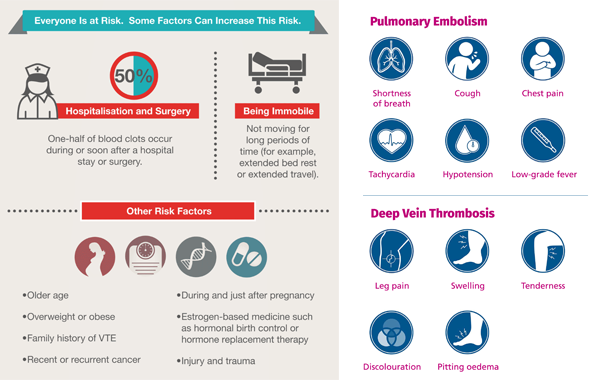Thrombosis
Thrombosis and CAT clinic patient feedback
We value your feedback. Please tell us about your experience of the Thrombosis and CAT clinic by completing the questionnaire below. What you tell us will help us to understand what we do well and what we could improve about the service we provide to patients.
Information for patients
Click on the image above to find out more.
Want to know more about your risk of blood clots in hospital? See the video below:
Advice for preventing blood clots See the video below:
How to inject Inhixa See the video link below:
NHS resources
This link from NHS UK has information about how to stay healthy and avoid blood clots:
This video was produced by physiotherapists from the RUH and shows you how to exercise after having a blood clot:
Risks, signs and symptoms

Thrombosis UK
A great source of information for preventing and treating thrombosis is:
On this site under "Know Thrombosis" you can find information regarding what a blood clot is, who is at risk, how you can prevent and so much more. There are also videos and films made by other patients that have suffered from blood clots, which many patients find really helpful.
Blood thinning medication
If you need information about blood thinning (anticoagulation) medication, you can find more information here:
RUH Patient Leaflets
The Trust leaflets below may be of some use to you:
Apixaban for the treatment of DVT/PE
Preventing a blood clot whilst in hospital
Unprovoked Venous Thromboembolism (unexplained blood clots)
Frequently Asked Questions (FAQs)
What is Post Thrombotic Syndrome (PTS)?
PTS is a chronic and potentially disabling condition, caused by damage to the veins, resulting in increased pressure on the vein walls that damage the valves which normally work to keep blood flowing up the leg. A reduction in the amount of blood being carried away from the foot and lower leg can lead to pain, swelling and, in the most severe cases, leg ulcers which are often slow to heal.Up to 30% of people who have had thrombosis in the leg will develop some post thrombotic symptoms within five years. Most episodes of post thrombotic syndrome will develop within six months to two years of the initial thrombosis. Some people will go on to develop severe problems, including venous ulcers and severe pain.
Physical signs and symptoms of PTS may include:
- aching or cramping
- a feeling of heaviness in the limb
- itching, tingling or pins and needles
- swelling
- discoloration of the skin
- hardening of the skin
- varicose veins
- venous ulcers
Can I fly after a blood clot?
We would recommend that you would wait 4 weeks after having a pulmonary embolism or an above knee DVT before flying, 2 weeks may be reasonable if a patient has had a calf DVT. When flying always remain hydrated and keep moving as much as possible.
Can I have cosmetic procedures whilst on blood thinner?
Procedures like tattoos, piercings, cosmetic aesthetic procedures, deep tissue massage, and acupuncture will lead to bleeding, bruising or both, and this can be made worse by being on a blood thinner.Are you likely to be on anticoagulants long-term? If not, you could wait until after your blood thinning treatment before having your tattoo for example.
Warfarin is a particular challenge because it stays in the body for a longer duration and can pose a challenge when planning any form of invasive treatment. This can include dental work too. Close monitoring and an INR test to check your clotting levels may be required to plan your treatment safely and if a practitioner has limited understanding of how anticoagulants work and the risk of bleeding then this could pose a serious risk for the individual.
Newer anticoagulants such as apixaban, dabigatran, edoxaban and rivaroxaban are cleared from the body much quicker and there may be an opportunity to simply adjust the timing of the dose without having to stop treatment. However, this is something to agree a plan in partnership with your GP or anticoagulation clinic. No health professional can say yes it is safe, we can only advise of the risks and allow you to make your own decision.


